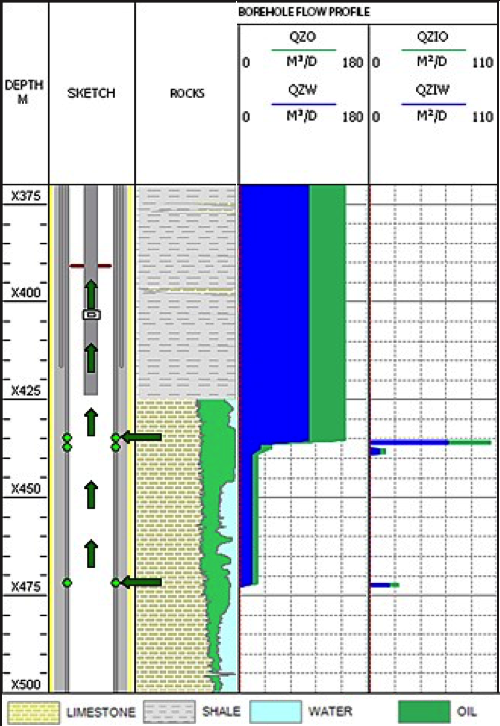
Both perforations are producing oil and water with upper interval producing more than lower.
The lower inflow zone is mostly producing water.
Fig.1. PLT in oil producer with oil and water production.
See ILT for example in injecting well.
Collective term for Cased-Hole Logging operations in producing wells with a purpose to assess Borehole Flow Profile (BFP) and/or Reservoir Flow Profiling (RFP):
| Borehole Flow Profile (BFP) | Reservoir Flow Profiling (RFP) | ||
| Borehole Production Profile | Borehole Injection Profile | Reservoir Production Profile | Reservoir Injection Profile |
PLT is essential part of the production and recovery monitoring and helps understand fluid communication at Well-Reservoir Contact.
For PLT in injection well see ILT, although it is often called PLT anyway.
The survey is performed with a multi-sensor downhole PLT Logging Tool and interpreted with PLT-BFP Model or PLT-RFP Model.
Picking up the fluid inflow intervals and phase characterization |
| Estimating flowrate of each phase component across each inflow interval |
| Check up for cross-flows in shut-in conditions between formation units with different formation pressure |
Picking up the zones of the first barrier (tubing and/or casing) integrity failure |
| Conclusions |
Both perforations are producing oil and water with upper interval producing more than lower. The lower inflow zone is mostly producing water. | |
Fig.1. PLT in oil producer with oil and water production. See ILT for example in injecting well. |
Petroleum Industry / Upstream / Data Acquisition / Well & Reservoir Surveillance / Well logging / Cased-Hole Logging
[ Well & Log Analysis ][ Borehole Flow Profile (BFP) ][ Reservoir Flow Profiling (RFP) ][ Temperature Logging ][ Noise Logging ]
[ PLT – Donwnhole Tools ] [ PLT – Logging Procedure ] [ PLT – Interpretation ] [ PLT – Samples ]
Richard Bateman, Cased Hole Log Analysis and Reservoir Performance Monitoring, 2015
|